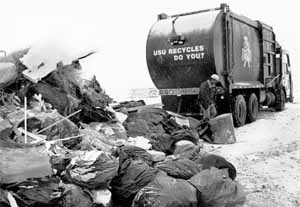USU recycles, do you?
From its beginning in 1990, Utah State University’s recycling program has grown to where the university has its own dedicated facility, said Kevin Phillips, manager of Resource Recovery.
Utah State University is the only university in the state of Utah that has its own facility for processing recyclable materials, Phillips said. A pilot program was started more than a decade ago by a coalition of environmentally-minded students which was so successful it was turned over to a professional contractor after about one year, he said.
Within one and one-half years from its beginning, the program was turned over to the university to manage.
“The whole program is self-supporting for the most part,” Phillips said.
Money is generated by the sale of recyclable materials to manufacturers which process and convert the used products into usable material. Additional money is given to the program by the university for the amount the university saves – money which would have been spent to dispose of the recyclable material, he said.
It costs about $50 per ton to dispose of waste produced by the university, Phillips said. That cost has tripled since the beginning of the recycling program and the cost is anticipated to be about $100 per ton in 10 years, he said.
Approximately 2,500 tons of garbage are produced per year by the university and only about 500 of those tons are recycled, Phillips said. Because the university runs a clean MRF (materials recovery facility), it does not sort garbage that is not already placed in a recycling bin at the time of disposal.
“The mindset has to change,” Phillips said.
For those who recycle, there are a few “rules of recycling,” Phillips said. To ensure that a product can be recycled, it should be emptied and rinsed. Often plastic containers are made of a different type of plastic than its own lid. The lid should be removed so that sorters don’t have to be slowed down by unscrewing lids, he said.
Phillips said recyclers should also be aware of which materials are recycled at the facility they use.
At the university’s facility, a variety of items are processed. These include: White paper, magazine paper, computer paper, paperboard, mixed paper, cardboard, milk jugs, plastic pop containers, aluminum cans, tin cans, brown glass, green glass, clear glass and Styrofoam. The university tries to add one or two new items each year, Phillips said.
Because of the high quantity of paper produced at the university, the facility’s focus has always been paper, he said.
Resource Recovery does not only handle waste that leaves the campus, it handles all items from campus that are no longer needed through surplus sales – which began in 1995. There is a hierarchy for handling everything that leaves the university, Phillips said. The first goal is to resale items of value. The second goal is to recycle. Items that don’t fit in those categories become refuse.

A garbage truck load of refuse like this is dumped at the Logan landfill almost daily. Of the approximately 2,500 tons of waste product produced by campus every year much of which is recyclable, only 500 tons actually are recyled. (Scott Davis )

